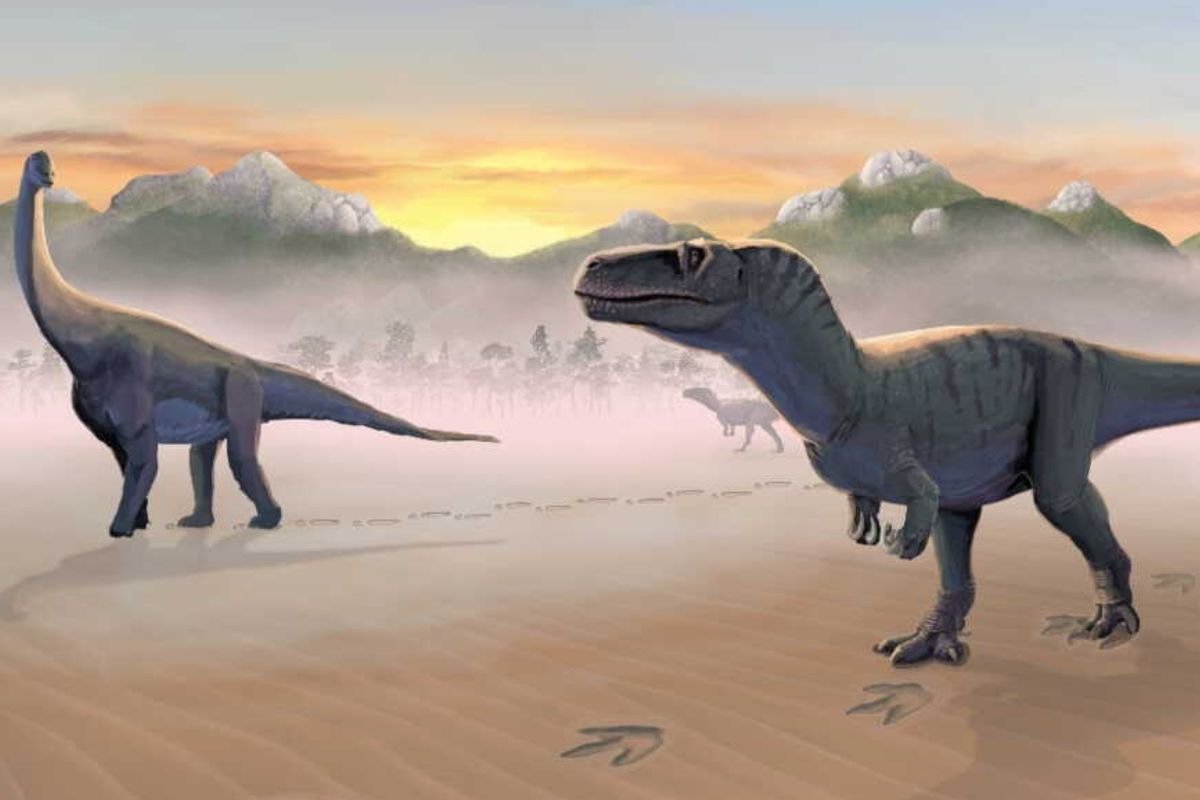Show table of content Hide table of content
The discovery of a 167-million-year-old dinosaur “highway” on Scotland’s Isle of Skye has thrilled paleontologists worldwide. This remarkable find includes 131 preserved footprints left by massive creatures that once roamed the subtropical landscape during the Middle Jurassic period. The tracks, measuring between 25 and 60 centimeters, offer unprecedented insights into the behavior of theropods and sauropods that inhabited this ancient Scottish terrain.
Ancient footprints reveal prehistoric giants of Skye
The Isle of Skye, often nicknamed the “Jurassic Park of the Hebrides,” has truly earned this moniker with the recent discovery documented in the scientific journal PLOS One on April 2, 2025. Researchers uncovered an extensive network of fossilized dinosaur tracks that have remained hidden in rock layers for approximately 167 million years.
The footprints were found at Prince Charles’s Point, a location that bears historical significance beyond paleontology. This same site is where Bonnie Prince Charlie landed and sought refuge during his escape across Scotland after the Battle of Culloden in 1746. Now, this area reveals a much older history—one that predates human civilization by millions of years.
During the Middle Jurassic period, Skye’s environment differed dramatically from today’s oceanic climate. The region featured a warm, humid subtropical setting dominated by shallow lagoons—saltwater bodies separated by sandbanks and islets. These giants walked across moist, rippled sands, leaving impressions that were rapidly covered by mud or sediments, thus preserving them through the millennia.
The research team led by paleontologist Tone Blakesley from the University of Edinburgh identified two distinct types of tracks. The first type shows three-toed (tridactyl) imprints created by bipedal theropods, while the second displays rounder impressions comparable to tire marks, made by quadrupedal sauropods. This fascinating puzzle of prehistoric evidence offers scientists valuable information about dinosaur behavior and distribution.
Diverse dinosaur species identified through track analysis
By comparing the footprint shapes with previously discovered fossils in the United Kingdom, scientists believe they’ve identified the likely creators of these ancient tracks. The three-toed impressions potentially belong to creatures similar to Megalosaurus, which measured between 7 and 9 meters in length. The larger, rounder tracks likely came from early members of the neosauropod group, such as Cetiosaurus, which could reach 15 to 18 meters in length.
Many tracks appear in continuous sequences, with the longest paths extending over 12 meters. The spacing and orientation of these trails indicate that these massive creatures moved at slow paces without apparent direction or interaction patterns. They wandered peacefully through the landscape at slightly different times, leaving behind a record of their movements that would remain undisturbed for millions of years.
Science This strange red lake in Tanzania turns animals to ‘stone’.
The site presents a higher proportion of theropod trails compared to other similar fossil locations. On Skye, these carnivorous dinosaurs seemed to prefer lightly submerged lagoon environments over partially wet mudflats accessible during low tide. This behavioral insight adds to our understanding of how different dinosaur species utilized various ecological niches within the same general environment.
Interestingly, researchers found no footprints from other specimens like stegosaurs—large quadrupedal herbivores with distinctive back plates—or ornithopods—often bipedal herbivores sometimes featuring crests or duck-bill-shaped beaks. Scientists remain uncertain whether these species truly avoided this environment or simply didn’t leave identifiable marks in the preserved sediment layers. This kind of scientific mystery reminds us of other unexplained phenomena across our solar system, such as the recently captured tornado on Mars documented by NASA.
Significance for dinosaur evolution and behavior studies
These newly discovered trackways provide crucial clues about the geographical distribution and behaviors of theropods and sauropods on the Isle of Skye during a key period in their evolution. The Middle Jurassic represents a critical timeframe when the major dinosaur groups were actively diversifying, making these findings particularly valuable for understanding dinosaur development.
The extensive nature of the trackways allows paleontologists to analyze movement patterns with unprecedented detail. Unlike isolated footprints, these continuous trails reveal information about stride length, walking speed, and possibly even social interactions. Such evidence helps scientists reconstruct not just the physical appearance of these creatures, but also aspects of their daily lives and behavioral tendencies.
Preservation of these tracks required specific environmental conditions—particular combinations of sediment consistency, water levels, and rapid burial processes. The exceptional quality of these footprints speaks to the unique geological processes that occurred in ancient Skye. While modern visitors to natural wonders must be respectful—unlike certain disrespectful tourists who faced consequences at the Great Wall of China—these ancient creatures unknowingly left their mark for future scientific discovery.
The broader implications for paleontological research
The Isle of Skye continues to yield remarkable fossilized treasures that enhance our understanding of prehistoric life. This “dinosaur highway” joins other significant paleontological discoveries from the region, cementing Skye’s reputation as one of Europe’s most important dinosaur fossil sites. The continuous research efforts paint an increasingly detailed picture of Jurassic ecosystems.
These findings contribute to the global paleontological record, allowing scientists to compare dinosaur populations across different geographical regions during the Middle Jurassic. Such comparisons help establish patterns of migration, adaptation, and evolution across prehistoric continents. The work represents a significant advancement in our knowledge of dinosaur ecology during a period from which relatively few fossils have been recovered worldwide.
As science continues to unlock Earth’s prehistoric secrets, we’re reminded of humanity’s brief existence compared to the dinosaurs’ lengthy reign. While we now contemplate space exploration and the potential deorbiting of the International Space Station, these ancient footprints connect us to a world that existed long before humans emerged—a humbling reminder of our planet’s incredibly rich and diverse history spanning millions of years.
Science 50 years later, a quantum mystery has finally been solved.


